Telecommunications History Group Resources
The Science of Phones
A Time Before Phones - The Science of Phones
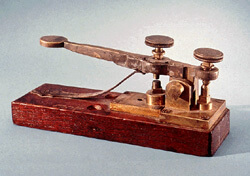
Morse/Vail telegraph key, 1844. This key was used to send the message “What Hath God Wrought” on the experimental line between Washington, DC and Baltimore, Maryland. (Photo by Alfred Harrell.)
Timelines Converge
The development of all the bits and pieces of the telephone make for interesting reading all by themselves (or perhaps you haven’t yet read the other articles in this section!), but it is at least as interesting looking over the various inventions that lead up to the telephone—and finding out just how many inventions went into making the phone possible.
What follows is a timeline taking us from the time before phones to the development of the phone itself.
Smoke Signals
The need to communicate has driven much development in human history, and the need to communicate over distances too great to shout over has been just as important. From smoke signals to semaphore, from signposts to sending letters via messenger, we have discovered faster and more effective means of communicating. Still, it became more and more necessary to communicate instantly (as when a battalion of soldiers needed to move to help their compatriots, or a government needed to stop a war entirely), and so messengers were too slow; and to communicate over more than line-of-sight distances (again, a government, say the ancient Romans, trying to stop its troops from fighting is a good example, unless the troops are all stationed in the Senate chambers to begin with).
One solution was a chain of signals—either smoke, flags, or signal fires—and this was used for thousands of years all over the world. It did, however, still have drawbacks, including that it took only one failed signal in the chain (due to sleepy guards, wood too wet to light, or what-have-you) to make the whole thing an act of futility.
But how else does one communicate beyond the sound of one’s voice and the line of one’s sight?
Electricity
As seems to have happened with a lot of things in history, electricity was “discovered”—or at least static electricity was—and then “forgotten” and then “discovered” again. The ancient Greeks, perhaps as early as 600 BC, had learned that they could create a static charge on amber by rubbing it, and that this charge could attract small bits of paper and other extremely light objects. They most likely also found out that you could shock your nearest friend with a static spark, but nobody seems to have thought that important enough to write down for posterity.
Little was done with this knowledge until around 1600 AD, when William Gilbert, an English scientist, published “De magnete, magneticisique corporibus” or “On the Magnet,” a treatise describing all of his experiments with what he called “electricity,” after the Greek word for amber. He talked about electric force, magnetic poles, electric attraction, and even the magnetic compass.
Lots of people became interested in static charges and electricity (and very soon were also interested in its relation to magnetism), and in fact it was discovered that electric impulses could be sent down a wire (as performed in 1729 by English chemist Stephen Gray). Still, the static electricity was fairly useless without some method of storing it, or of calling it up at will.
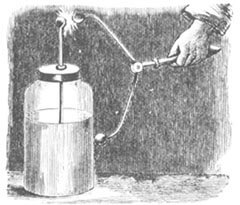
Leyden Jar being discharged (unknown)
Holding Lightning in a Bottle (Leyden Jar)
In or around 1745 the Leyden Jar was invented by Dutchman Pieter van Musschenbroek. A Leyden Jar finally allowed the storage of static (or any other kind of) electricity. Through applying an electric charge to the electrode, one would set up a situation in which positive and negative charges accumulated from the two metal coatings on the outside and inside of the jar, but these charges could not discharge because of the glass between them. The only way for the charge to dissipate was to provide a discharge path, for instance by touching the electrode with a conductive object, like copper or your finger (which would be a very bad idea).
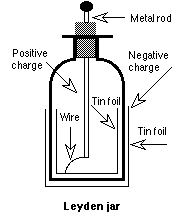
Diagram of Leyden Jar (from Tom Farley’s Privateline.com)
According to Privateline.com, in 1753 an unknown writer in The Scot’s Magazine posited that one could transmit messages using electricity, and through a complicated set of wires (at least 26, one for each letter of the alphabet), bits of paper representing each letter, and an electrostatic generator one could send messages. The generator would send an electric impulse down the line for the letter you wanted to “type,” and the bit of paper representing that letter at the other end would be attracted to the line. This sort of thing worked well enough, but it was very cumbersome and could only work over a couple of miles.
Benjamin Franklin, of kite-and-lightning fame, created a set of bells sometime in the mid- to late 1700s that would ring due to electrical charges attracting and then repelling one another if he charged a bell in the first place. One way to do this was with the Leyden Jar. Another was to attach the bells to a lightning rod; then, whenever a lightning storm approached, the bells would go off.
But even with the ability to store static electricity and discharge it, there were difficulties, the most important of which was static’s inability to really be very energetic. While it could attract a light ball or a bit of paper, it couldn’t do much more, and it could only do it once the Leyden Jar had been charged, which took time.
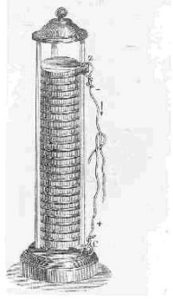
Art depicting Volta’s battery, alternating two metals and brine-soaked paper (unknown).
Better Lightning through Chemistry (Batteries)
Inventors and scientists being an inventive, creative, and curious lot, they spent the next few decades looking for an answer to the static charge problem. They tried many materials and many ways of generating electric charges, including many metals and even organic (as in biological) substances, but no one hit upon the right combination until 1800. In that year, Alessandro Volta of Italy created a tower of alternating discs of zinc and copper (or silver; authorities disagree as to which was used), with pieces of blotting paper soaked in brine (salt water) between, and the contraption produced electrical current. How? Through a chemical reaction between the metals, which caused a flow of electrons to move from one end of the battery to the other if the two ends were connected by a conductive material. If one attached a wire to one end, then looped it around and connected it to the other end of the battery (or “voltaic pile,” as it came to be known), one created a circuit in which electrons flowed (or were forced by the chemical reaction between the metals) from one end of the pile to the other, then were forced out by the continuing flow into the wire, then flowed back to the other end of the battery and were sucked in by the chemical action of the battery pulling electrons in one end and forcing them out the other. And so on, for as long as the chemical reaction continued. These first batteries worked for a very short time (say, closer to tens of minutes than to days or months), but could be made more powerful simply by adding more alternating layers of metals and brine-soaked paper.
Of course, a battery meant electrically powered objects, and a steady electrical current, which of course most old phones and certainly all new ones need; in fact, the quest for better and better batteries has continued since Volta’s time, resulting in highly effective combinations like Nickel-Cadmium.
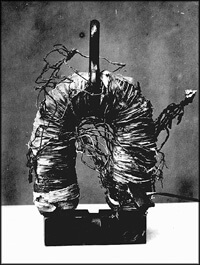
Surviving Henry electromagnet, which he termed “quantity magnet.” (Smithsonian neg. no. 39040).
Magnetic Personalities (Electromagnets)
Of course, getting electric current running through your phone is one thing, but getting it to do anything is another. And a key to that is electromagnetism.
The discoverer of electromagnetism was Danish physicist Christian Oersted. In 1820, during a classroom demonstration, he discovered that current running through a wire caused a compass needle to shift. (The demonstration is rumored to have been on heating and electricity, and the compass was in its position accidentally; however, accounts differ, with Oersted indicating that the compass was there on purpose to test precisely the effects of electricity on it, while student accounts state that the lecture was on heating and electricity and had nothing to do with magnetism.)
Whatever the case, this discovery lead to the idea that an electric current creates a magnetic field, and indicated that the reverse—a magnetic field creating an electric current—was possible.
Pushing Electricity with Your Hand (Faraday)
Ten years after Oersted’s discovery, Michael Faraday of London made a discovery of his own—how to reverse the process. First, using an “induction ring,” which consisted of wire wrapped in a coil around an iron ring, he discovered electromagnetic induction, or a way to generate electricity from magnetism. Then, in another set of experiments, he discovered that by rotating a copper disc (with wires attached) between the poles of a horseshoe magnet, he could induce not only a current, but a steady current that could be used in lieu of a battery to send electrical power through wires.
This finally allowed electricity—which had been a capricious ally at best—to be used as a source of power for whatever inventors could come up with. It’s relationship with magnets meant it could move metal objects, and the eventual discovery (by James Clerk Maxwell in 1865) that all electromagnetic phenomena can be described as waves moving through space lead eventually to radio communication (put to practical use by Guglielmo Marconi by the beginning of the 20th century and eventually used to carry phone conversations over long distances—see our article on long distance).
Telegraph!
The telegraph is the immediate predecessor to the telephone; in fact, many people thought the telephone was unnecessary, as the telegraph already performed the function of instantly sending a message down a wire to an anxious party on the other end. Why add the novelty of voice to the mix? This thinking lead Western Union (the giant of the telegraph industry) to refuse Bell’s offer to buy the patents to the telephone in 1876 and changed the course of telephone history.
The telegraph had its origins in experiments by Professor Joseph Henry of the Albany Academy in New York. Henry was a preeminent scientist, creating an electromagnet powerful enough to send significant electrical energy over great distances, and he later became the first director of the Smithsonian Institution.
In 1831 Henry demonstrated, in his classroom, that electricity could be used to ring a bell from a distance. He strung a mile of copper wire inside the Academy, connected this to an electromagnet, placed a pivoting steel bar next to this, and placed a bell next to the bar. He then completed the circuit by connecting the ends of his wiring to a battery. When he did so, the electricity flowing down the wires from the battery caused the electromagnet to become magnetic, which then attracted the steel bar, which swung and hit the bell. Turning the magnet off (by removing the wires from the battery) caused the steel bar to swing back away from the bell, back to its natural resting position. Connecting the circuit again caused the bell to ring again … and so forth. Although this was very much like Franklin’s bells (see above), the key was that now the bell could be rung over a distance, at will.
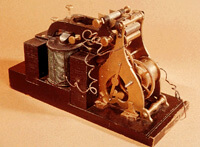
Morse/Vail telegraph register, 1844. This register was used to receive the message “What Hath God Wrought” on the experimental line between Washington, DC and Baltimore, Maryland. (Smithsonian Photo by Alfred Harrell).
Morse eventually received public funding to test his device by setting up a line between Baltimore and Washington, DC. As he was setting up the line in 1844, the Whig party nominated Henry Clay as its presidential candidate. This news was hand-carried to the newly-laid telegraph wire (which had reached Annapolis Junction, still miles away). The news was sent by telegraph back to Washington and became the first signal sent down the line.
Three weeks later, on May 24, 1844, the line officially opened with the message, “What hath God wrought?” (a bit of irony chosen by Annie Ellsworth, a daughter of a friend of Morse). Less than ten years later, Morse had wrought a change in the communications industry like no other. Nearly 25,000 miles of telepgraph wire had been laid across the country, the telegraph was being used to dispatch trains, and communication had never been easier. By 1861, Western Union built a transcontinental telegraph line, and the telegraph had made itself an integral part of the US landscape.
A Sausage Skin (and a Bit of Variable Resistance) Away from a Telephone
Even as the telegraph was taking off, some people were thinking of ways to transmit speech, rather than mere impulses of electricity, down wires. M. Charles Bourseul, a French telegraphist, came up with the idea of using a “movable disc” that “alternately makes and breaks the currents from a battery: you may have at a distance another disc which will simultaneously execute the same vibrations” (L’Illustration de Paris, 1854 magazine).
Then in 1861, fifteen years before the invention of a working telephone, Johann Phillip Reis, a German physicist and teacher, completed an almost-but-not-quite-working version of the telephone. Using parts of a beer barrel, a sausage skin, and a piece of platinum, he managed to send musical notes down a line to a receiver, which then played the notes. Unfortunately, he was trying to make a telephone using the same principle as the telegraph—by making and breaking circuits. While this worked fine for dots, dashes, and notes all of one pitch, it could not re-create the human voice, as speech is a continually changing sound, rather than a discrete set of sounds. It would take the concept of variable resistance, and of sending an uninterrupted current through the wiring, to create the telephone and with it the next communications revolution.
